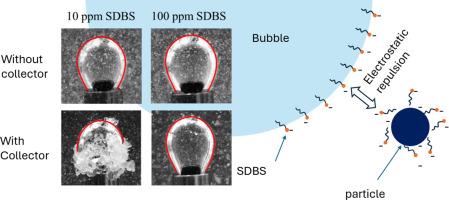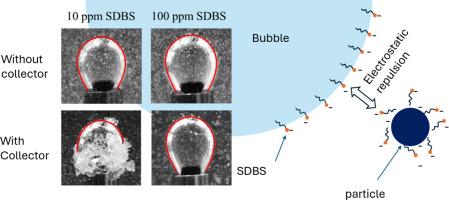离子表面活性剂污染物对聚苯乙烯-气泡相互作用去除废水中微塑料的影响
IF 12.4
1区 环境科学与生态学
Q1 ENGINEERING, ENVIRONMENTAL
引用次数: 0
摘要
微塑料是普遍存在的环境污染物,迫切需要从水生系统中有效去除。泡沫浮选作为一种有前途、经济、环保的微塑料去除技术,近年来受到了人们的关注。然而,浮选性能取决于气泡-颗粒的相互作用,而表面活性剂在城市和工业废水中广泛存在,可以深刻地改变气泡-颗粒的相互作用。尽管表面活性剂在MPs和气泡上的吸附会影响这些相互作用,但目前还没有系统的研究。在这项工作中,我们评估了两种离子废水表面活性剂:阴离子十二烷基苯磺酸钠(SDBS)和阳离子十六烷基三甲基溴化铵(CTAB)如何影响原生和光老化聚苯乙烯(PS)微塑料的表面特性,以及它们如何影响油酸钠(NaOL)作为浮选捕收剂的效果。我们证明了MP老化和表面活性剂吸附强烈地改变了表面润湿性,从而改变了气泡颗粒的附着。虽然NaOL可以有效地恢复清洁系统中老化MPs的疏水性,但随着SDBS或CTAB浓度的增加,其有效性显着下降。这些结果揭示了MP表面特性、表面活性剂污染和收集器性能之间复杂的相互作用,强调了在开发基于浮选的MP去除策略时需要考虑废水表面活性剂的不利影响。本文章由计算机程序翻译,如有差异,请以英文原文为准。


Influence of ionic surfactant contaminants on polystyrene-air bubble interactions for microplastics removal from wastewater
Microplastics are pervasive environmental pollutant, creating an urgent need for effective removal from aquatic systems. Froth flotation has recently gained attention as a promising, cost-effective, and environmentally friendly technique for microplastic (MP) removal. However, flotation performance depends on bubble–particle interactions, which can be profoundly altered by surfactants which are widespread in municipal and industrial wastewaters. Despite their constant presence, no systematic studies have examined how surfactant adsorption onto MPs and air bubbles affects these interactions. In this work, we assess how two ionic wastewater surfactants: anionic sodium dodecylbenzenesulfonate (SDBS) and cationic cetyltrimethylammonium bromide (CTAB) affect the surface characteristics of virgin and photo-aged polystyrene (PS) microplastics, and how they impact the efficacy of sodium oleate (NaOL) as a flotation collector. We demonstrate that MP aging and surfactant adsorption strongly change surface wettability and thereby bubble–particle attachment. Although NaOL effectively can restore the hydrophobicity of aged MPs in clean systems, its effectiveness declines markedly with increasing SDBS or CTAB concentration. These results reveal a complex interplay among MP surface properties, surfactant contamination, and collector performance, highlighting the need to consider the adverse impacts of wastewater surfactants when developing flotation-based MP removal strategies.
求助全文
通过发布文献求助,成功后即可免费获取论文全文。
去求助
来源期刊

Water Research
环境科学-工程:环境
CiteScore
20.80
自引率
9.40%
发文量
1307
审稿时长
38 days
期刊介绍:
Water Research, along with its open access companion journal Water Research X, serves as a platform for publishing original research papers covering various aspects of the science and technology related to the anthropogenic water cycle, water quality, and its management worldwide. The audience targeted by the journal comprises biologists, chemical engineers, chemists, civil engineers, environmental engineers, limnologists, and microbiologists. The scope of the journal include:
•Treatment processes for water and wastewaters (municipal, agricultural, industrial, and on-site treatment), including resource recovery and residuals management;
•Urban hydrology including sewer systems, stormwater management, and green infrastructure;
•Drinking water treatment and distribution;
•Potable and non-potable water reuse;
•Sanitation, public health, and risk assessment;
•Anaerobic digestion, solid and hazardous waste management, including source characterization and the effects and control of leachates and gaseous emissions;
•Contaminants (chemical, microbial, anthropogenic particles such as nanoparticles or microplastics) and related water quality sensing, monitoring, fate, and assessment;
•Anthropogenic impacts on inland, tidal, coastal and urban waters, focusing on surface and ground waters, and point and non-point sources of pollution;
•Environmental restoration, linked to surface water, groundwater and groundwater remediation;
•Analysis of the interfaces between sediments and water, and between water and atmosphere, focusing specifically on anthropogenic impacts;
•Mathematical modelling, systems analysis, machine learning, and beneficial use of big data related to the anthropogenic water cycle;
•Socio-economic, policy, and regulations studies.
 求助内容:
求助内容: 应助结果提醒方式:
应助结果提醒方式:


